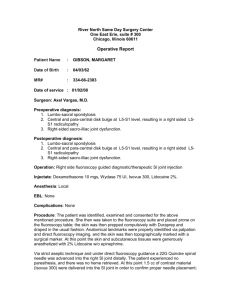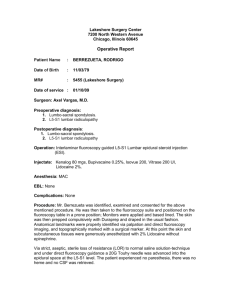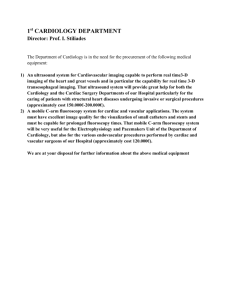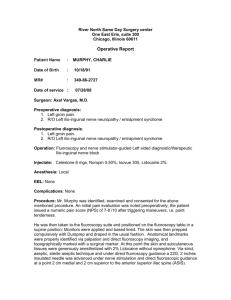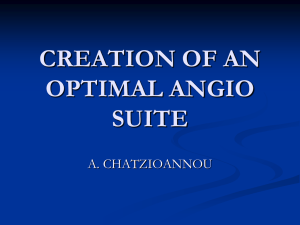Guide for Establishing a Credentialing and Privileging Program for Users of
advertisement
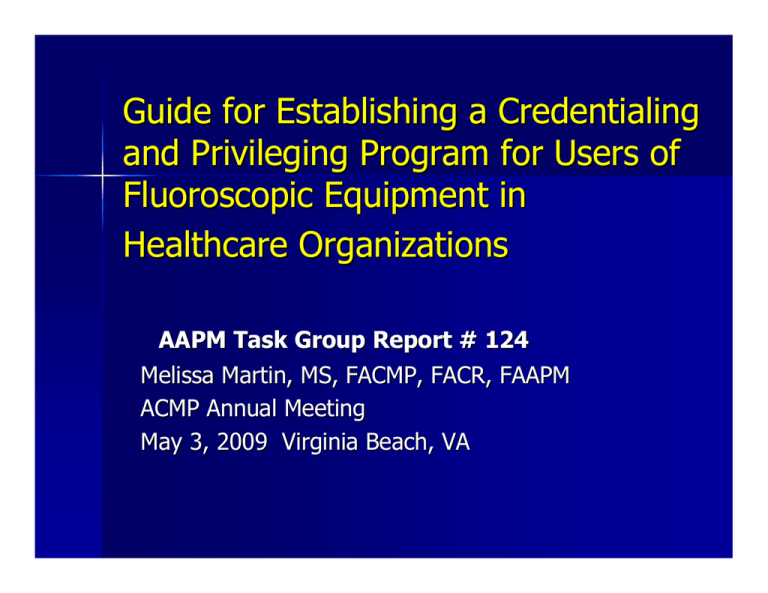
Guide for Establishing a Credentialing and Privileging Program for Users of Fluoroscopic Equipment in Healthcare Organizations AAPM Task Group Report # 124 Melissa Martin, MS, FACMP, FACR, FAAPM ACMP Annual Meeting May 3, 2009 Virginia Beach, VA Membership of Committee Mary E. Moore, M.S., Chairperson Stephen Balter Joel E. Gray Alan M. Jackson Pei-Jan Paul Lin Melissa C. Martin Keith J. Strauss Lynne Fairobent, AAPM Staff Need for Credentialing and Privileging Program Fluoroscopy usage continues to increase in all areas of medicine Training for the safe use of fluoroscopy has not kept pace with increasing clinical applications Lack of appropriate training has resulted in increasing number of injuries Who Needs to be Trained? Physician Specialists such as: Radiologists Cardiologists Gastroenterologists Orthopedic Surgeons Urologists Pain Management Specialists Vascular Surgeons Who Needs to be Trained? Non-Physician Groups such as: Radiology Assistants Speech Pathologists Nurse Practitioners Physician Assistants Radiologic Technologists Who is at Risk? The Patient The Operator Support Staff Facility Program Components Didactic Content – Radiation Biology – Radiation Protection Principles – Radiation Imaging Physics Formal Support by Facility Management Acceptance by the Medical Staff Credentialing and Privileging Programs Process for Healthcare Facilities to assure the quality and safety of medical care provided by their staff Essential part of Healthcare Organizations today to meet Joint Commission (JC) requirements for accreditation Two separate and distinct programs Credentialing Program Collection of relevant for the individual applying for privileges to perform specific medical procedures at an institution Collection of necessary documentation such as applicant’s education, training, experience and continuing education Verification of supplied documentation Privileging Program Delineation of Medical Procedures that an individual may perform - may be global in nature (diagnostic imaging procedures) or specific (CT, MRI, Interventional Procedures, etc.) Medical Director and/or Department Chair makes recommendations to Medical Executive Committee for Specific Privileges JC Requirements for Privileging JC requires each facility to review and revise clinical privileges and appointments at least every two years Each facility must have a reprivileging process clearly defined in its bylaws and procedures manual Basic Elements of Program Identification of Individuals to be trained Individuals trained at other institutions may not need further training or Individuals trained at other institutions may need to have their training further augmented Training Program Content Level of training should be commensurate with level of risk of procedure to be performed by the trainee. Three levels of training are suggested. Low Risk Procedures Procedure/Equipment Mini C-arm Orthopedic Reduction or Extremity Surgery Training Suggested 1.0 hours didactic lecture & exam, followed by 0.5 hour ‘hands-on’ demonstration & exam Moderate Risk Procedures Procedure/Equipment Mobile C-arm R/F Table GI/GU Pain Management Urology Bronchoscopy Training Suggested 2.0 hours didactic lecture & exam, followed by 1.0 hour ‘hands-on’ demonstration & exam High Risk Procedures Procedure/Equipment Interventional Fluoroscope Interventional Procedures performed in Radiology, Cardiology or OR Training Suggested 3.0 hours didactic lecture & exam, followed by 1.0 hour ‘hands-on’ demonstration & exam Components of Training Basic Radiation Protection Considerations Radiation Safety Principles Radiation Health Effects Personnel Monitoring Patient Dosimetry Hospital Policies State Regulations Practice Guidelines Components of Training Other Program Contents Basic X-Ray Physics Fluoroscopic Imaging Physics Equipment Design Image Quality Improvement Radiation Dose Reduction Techniques Quality Control Practices Components of Training After the fundamental principles are covered, trainees should receive “Hands-On” training on the equipment they will actually be using to optimize image quality and dose Examinations & Assessment Student must pass a written exam with a minimum score of 70% prior to the initial clinical use of fluoroscopy If student fails test three times, he/she must repeat didactic course and retake the test Hands-On Demonstration on Equipment All applicants must demonstrate ability to operate equipment properly while performing the type of procedure they will perform Review of the applicant will be done by a previously authorized fluoroscopy user or QMP or other qualified person. Techniques to be Demonstrated Ability to achieve acceptable image quality Use available methods to reduce radiation dose to patient and staff Proper collimation, minimum patientimage intensifier distance, maximum patient-source distance, pulsed fluoroscopy mode Frequency of Training and Duration of Privileges Duration of privileges should not exceed a period of two years Fluoroscopy privilege renewal should be synchronized with the physician’s other privileging process to minimize administrative burdens Frequency must comply with state requirements Renewals Requirements for renewals may vary according to state or local regulations Refresher didactic training may be optional prior to successful repeating of the written examination If new equipment, demonstration of competency must be completed prior to usage on patients Trainers Variety of individuals may be involved in training such as: Radiologist or other physician familiar with use of the equipment for specific procedures QMP may develop curriculum and perform didactic lectures Compliance Requirements Fluoroscopy training program must be compliant with local, state and federal requirements One goal of training program is to prevent the occurrence of a sentinel event defined by JC as the delivery of 15 gy (1500 rad) to a patient Administrative Requirements Proper administrative elements of a fluoroscopy training program are necessary to ensure success of the program To receive privileging to use fluoroscopic equipment, applicant must demonstrate knowledge included in fluoroscopy training program Administrative Requirements Individual at each institution that handles privileging program must be identified. Availability of didactic training is key component of program Live Lecture or Web-Based Module Experienced Fluoroscopy Users Reasonable requirements may depend on previous training Experienced user may skip didactic training and/or demonstrate knowledge of didactic content by taking exam and demonstrating competency of equipment operations Components of Privileging Program Medical Staff Office provides management and oversight of all medical staff privileging Credentials Committee is responsible for reviewing all initial and reappointment applications for fluoroscopy privileging Components of Privileging Program Medical Staff Executive Committee is responsible for all clinical operational standards and policy Board of Directors approves physician privileges based on recommendations of the Medical Staff Executive Committee Model Policy for Fluoroscopy Privileging Program Ad-hoc committee to write policy Training required - based on TG124/State regulations Who provides training Frequency and of re-training per TG124/State regulations specifics Implementation of Fluoroscopy Privileging Program Procedure jointly developed by Medical Staff Office and Radiation Safety Officer and approved by both the Radiation Safety and Medical Executive Committee Implementation of Fluoroscopy Privileging Program Tracking of Fluoroscopy Use in Institution Quality Management Program Policy for Fluoroscopy Usage Compliance with the Policy by Fluoroscopy Users Role of the Radiologic Technologist Low Risk Fluoroscopic Procedures Complies with institution’s clinical privileging requirements for clinical examinations, and Complete didactic training for low risk fluoroscopy, and Pass exam on didactic material, and Demonstrate competency using low risk units Moderate Risk Fluoroscopic Procedures Complies with institution’s clinical privileging requirements for clinical examinations and Complete didactic training for moderate risk fluoroscopy, and Pass exam on didactic material, and Demonstrate competency for moderate risk units High Risk Fluoroscopic Procedures Complies with institution’s clinical privileging requirements for clinical examination, and Complete didactic training for high risk fluoroscopy, and Pass exam on didactic material, and Demonstrate competency for high risk units Trainees working under supervision of privileged users during training Shall successfully complete following during first six months of training: Complete didactic training at the appropriate level of fluoroscopy risk for their specialty, and Pass exam on didactic material, and Demonstrate competency at the level of fluoroscopy risk for their specialty. Credentials Committee Should have written criteria for not renewing privileges Reasons for Review Prior to Renewing Fluoroscopy Privileges: Excessively long procedures times and high patient doses Unsafe radiation safety practices High or missing personnel dosimeter readings Credentials Committee Reasons for Review Prior to Renewing Fluoroscopy Privileges: Failure to successfully complete the didactic exam Failure to complete practicum requirements Failure to acquire continuing medical education (CMEs) requirements. Any other missing elements of the program Delineation of Authority The Radiation Safety Committee has the authority to revoke or not to renew all approvals. The Medical Executive Committee also has the authority to revoke or not to renew privileges. Organization Policy Since privileges are granted by an institution, the fluoroscopy privileging program needs to be an institutional policy, not a departmental policy Each facility must have its own review policy involving Department Chairs, the QMP, RSO and Medical Executive Committee/Staff Thank You !!! Melissa C. Martin, M.S., FACMP Therapy Physics Inc. 879 West 190 St., Ste 419 Gardena, CA 90248 Office Phone: 310-217-4114 e-mail: Melissa@TherapyPhysics.com

